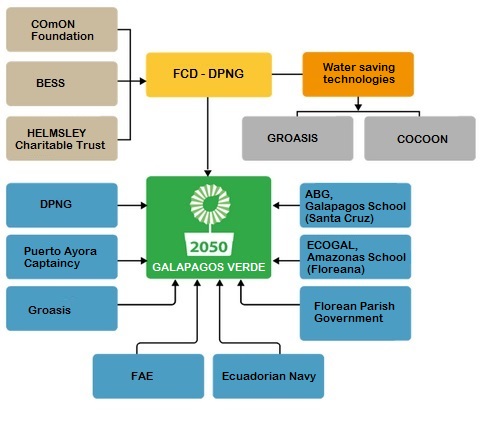GALAPAGOS VERDE 2050'S FORMATION
Galapagos Verde 2050 started with a agreement in 2014 between Fuente de Vida Foundation of Ecuador, as a representative for the Dutch organization Groasis, and the Charles Darwin Foundation, with an initial financing from COmON Foundation. The objective of this agreement was to develop a pilot project to test the Groasis Technology in the Galapagos Archipelago.
The Charles Darwin Foundation considered the possibilities of using this technology as a tool for ecological restoration, and coordinated with The Galapagos National Park Directory to execute a pilot project. The project was implemented under the guidance of the Galapagos Protected Areas Management Plan, the Conservation and Restoration of Ecosystems, the Wise use of the Ecosystem Services and its Biodiversity for Conservation and Development program, and the Ecuadorian Government. Two strategic approaches were established: Ecological restoration and Sustainable agricultural practices.
Preliminary results in ecological restoration and sustainable agricultural practices indicated that the Groasis Technology was effective on insular conditions such as the ones in the Galapagos, and thus, the implementation of Galapagos Verde 2050 was deemed viable. Some examples can be seen with native and endemic species tested during the pilot project in the ecological restoration component.
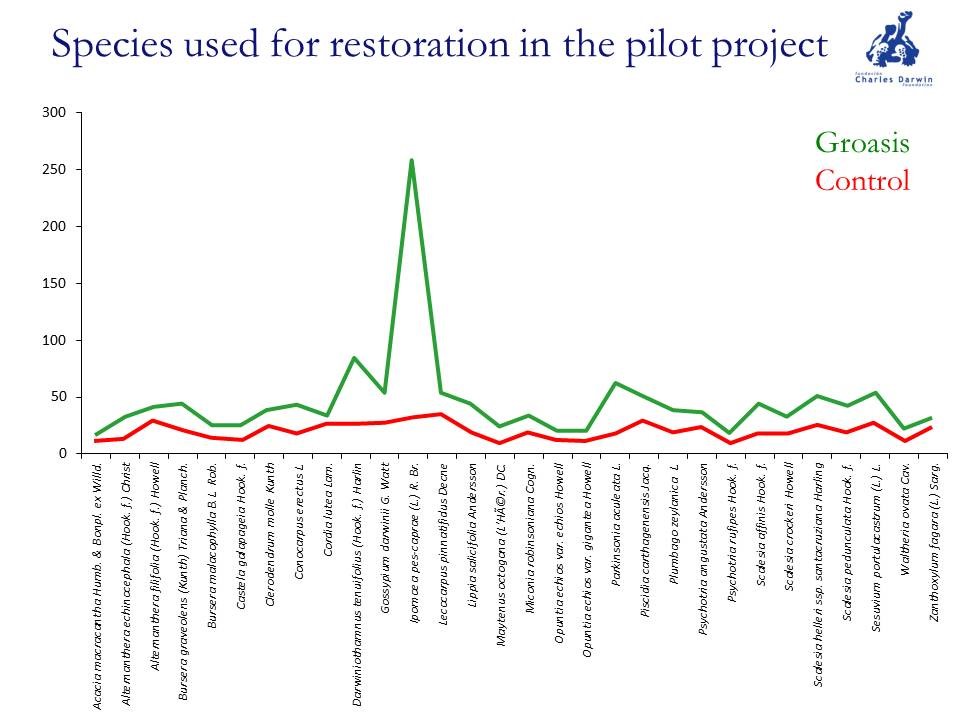
Representative graph of some natives and endemic species used in Galapagos Verde 2050 pilot project in the ecological restoration component.
WHO MAKES UP GALAPAGOS VERDE 2050?
The Galapagos Verde 2050 Project is implemented by The Charles Darwin Foundation and Galapagos National Park Directory. Financially, the project is possible thanks to the unmeasurable support of COmON Foundation, The Leona M. and Harry B. Helmsley Charitable Trust, and BESS Forest Club.
The most involved partner in the project is The National Park Directory, with whom the pilot ecologic restoration project on the islands of Baltra, Floreana, and Santa Cruz was developed. The Galapagos Verde 2050 Project also coordinates with The Autonomous Descentralized Government of Floreana, General Captaincy of Puerto Ayora, Ecuadorian Air Force, Ecological Airport of Baltra, Santa Cruz Municipality, La Iguana Foundation, and The Biosecurity and Quarantine Regulation and Control Agency for Galapagos.
Strategic partners and part of the Galapagos Verde 2050 team.
Our research team
The Galapagos Verde 2050 research team is composed of highly qualified professionals: biologists, agronomist, and field assistants. Additionally, the project has the support of local and international volunteers collaborating with The Charles Darwin Foundation.
[PICTURES OF THE TEAM]
Main Researcher
Researcher

Junior Researcher

Technical Assistant
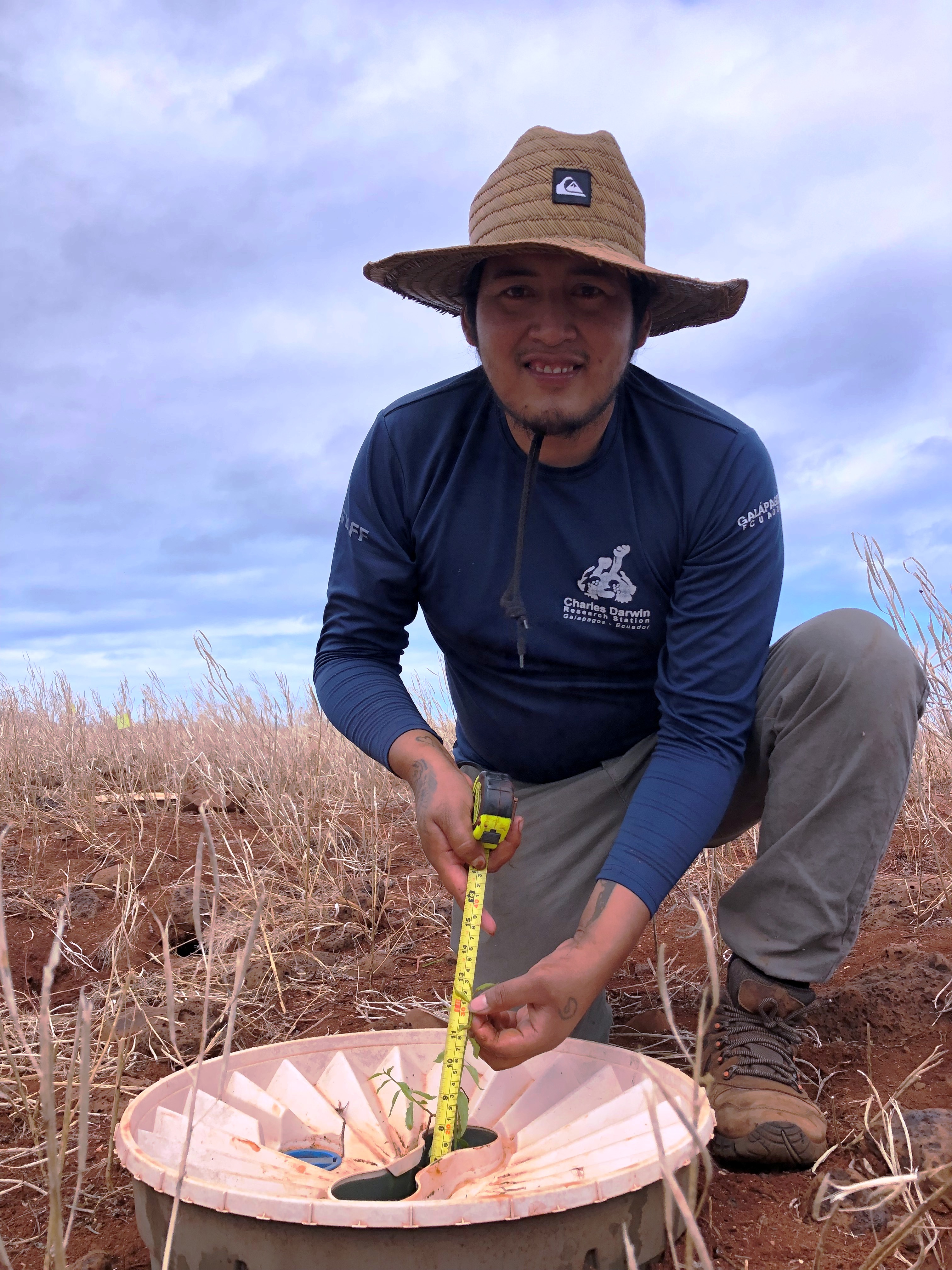
PROGRAM DETAILS
PHASES OF THE PROGRAM
The Galapagos Verde 2050 Program consists of three phases that are being developed on eight islands: Santa Cruz, Española, Isabela, Baltra, Floreana, Santiago, Plaza Sur, and San Cristobal. These are projects that are aimed at the ecological restoration of special use areas (Baltra, Floreana and San Cristobal), rural restoration (Santa Cruz, San Cristobal and Floreana), urban restoration (Santa Cruz, San Cristobal and Floreana), and recovery of endangered species (Santa Cruz, Española, Isabela, Baltra, Santiago and Plaza Sur).
- Phase 1: It commenced in July 2014 and was successfully completed in July 2017. Restoration activities included: Floreana, Baltra, Plaza Sur (South Plaza) and Santa Cruz. Pilot experiments on sustainable agricultural practices were conducted on Santa Cruz and Floreana. This phase has concluded, and the pilot results have informed the next phases of the projects.
- Phase 2: It commenced in August 2017 and will continue until July 2027. Ecological restoration activities began in Floreana, Santa Cruz, San Cristobal, Plaza Sur, Baltra, Isabela Norte and Española Island. Additionally, sustainable agriculture activities began on the islands of Floreana, San Cristobal and Santa Cruz. As of winter 2022, sustainable agricultural projects have been completed, while rural ecological restoration actions using native and endemic plants continue.
- Phase 3: The last and most extensive phase of the program will initiate in August 2027 and will be completed in December 2050. Restoration activities will take place on Santa Cruz, Isabela, Floreana, San Cristobal, Santiago, Baltra, Plaza Sur and Española Island.
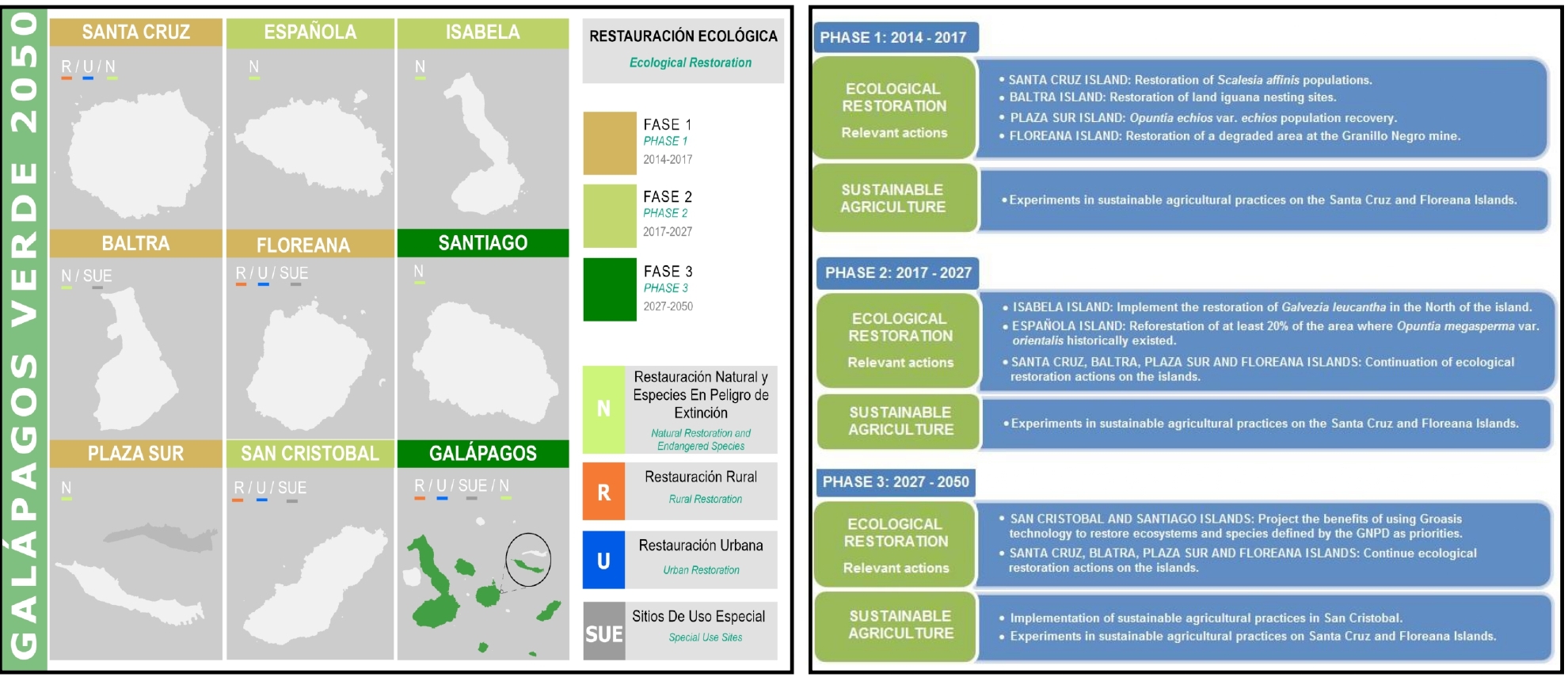
WATER SAVING TECHNOLOGIES AND TOOLS FOR ECOLOGICAL RESTORATION
A large percentage of the territory of the Galapagos Islands is arid. Periods of drought and lack of freshwater supply create difficulties for the implementation of ecological restoration processes. To address these water-related challenges, GV2050 resorts to the use of recently developed water-saving technologies and other tools, such as Groasis Waterboxx® (Waterboxx), Groasis Growboxx®, Cocoon, Hydrogel and BioChar, which have been successfully used around the world to increase the survival and growth of species native to arid environments. The use of these technologies can accelerate ecological restoration efforts and reduce irrigation costs.
▪ Groasis Waterboxx Technology® consists of a polypropylene reservoir that collects and retains water, supplied manually or obtained from rainfall. The water passes through a wick at the base of the box into the area surrounding the plant's roots, which will allow a constant supply of water to the plant. Waterboxx enables accelerated growth and stimulates vertical growth of the main root, increasing the plant's chances of survival. This technology is removed once the plant has developed enough to survive on its own. This system can be reused up to 10 times.
See examples about Groasis technology in Galapagos
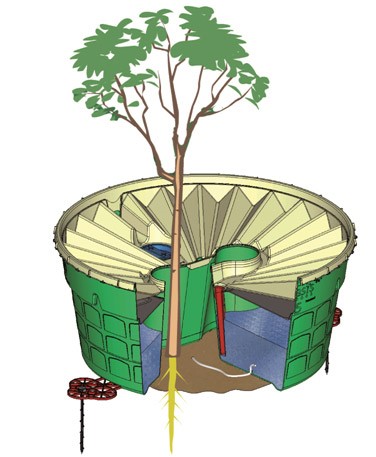
Groasis Waterboxx Technology ®.
▪ Cocoon biodegradable boxes function similarly to the Groasis Waterboxx technology, however, they are made of biodegradable material and are designed to remain in place and decompose over time. They are not designed to collect rainwater. This technology has been less successful in experiments in the archipelago on some species. In extremely arid terrain such as Baltra, it slows down the degradation process.
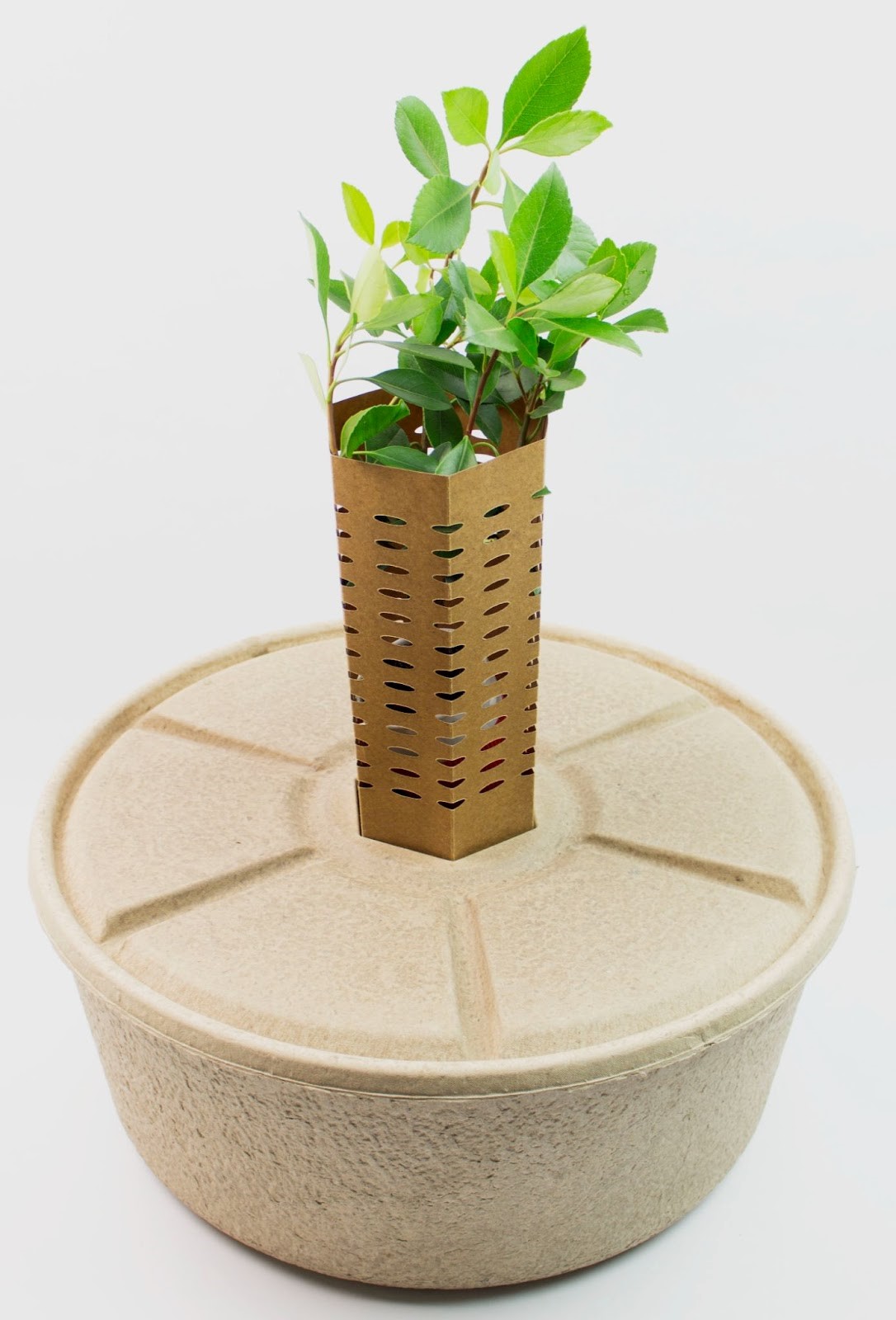
Cocoon Technology.
▪ Growboxx Technology, also produced by Groasis, was introduced to the project in October 2020. It is a square box with a hole in the center, made of recycled paper pulp and can be used for a one-time planting. It is placed around a sapling, it has 4 small holes in the lid where soil and seeds can be placed to germinate hydroponically in the container's stored water. While the small "planters" in the lid are not applicable to our tree and woody shrub restoration projects, they can serve as rainwater collectors to supplement the water supplied at planting and can therefore be more effective in ecological sites in Galapagos.
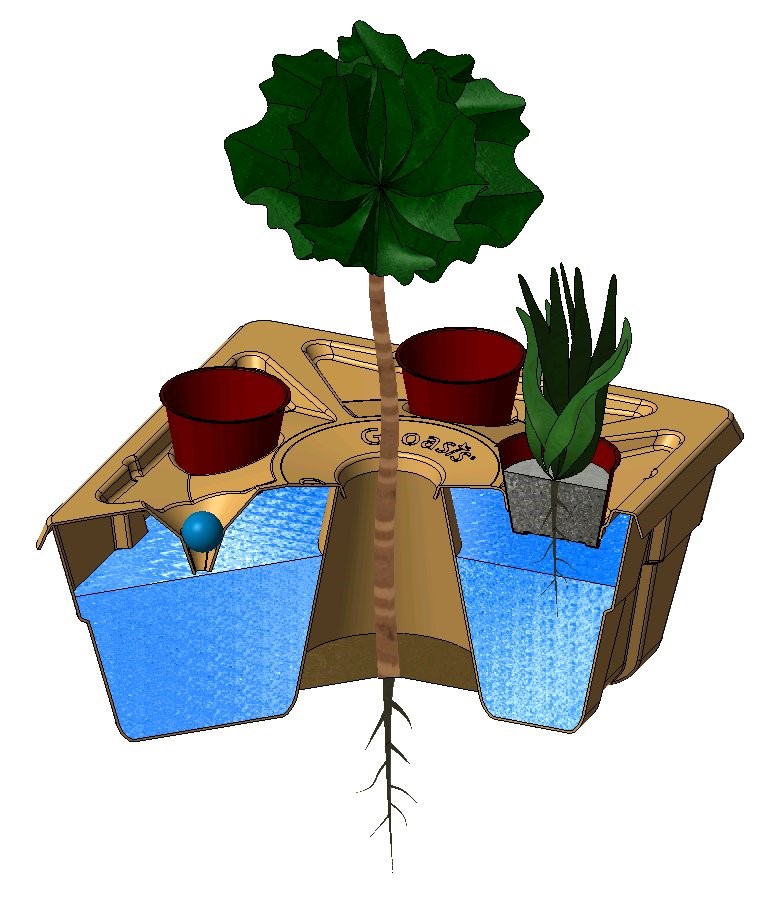
Growboxx Technology.
▪ Hydrogel, is a compound of insoluble polymers possessing gel-forming abilities with the potential for water retention in the soil. Hydrogel products are composed of a group of polymeric materials (potassium polyacrylate) whose hydrophilic structure makes it possible to retain large amounts of water.
Hydrogel is also used in combination with technologies that include physical water reservoirs. More information on water-saving technologies and the protocols for their installation and use are available in the Processes and Technologies Manual of the Galapagos Verde 2050 project.
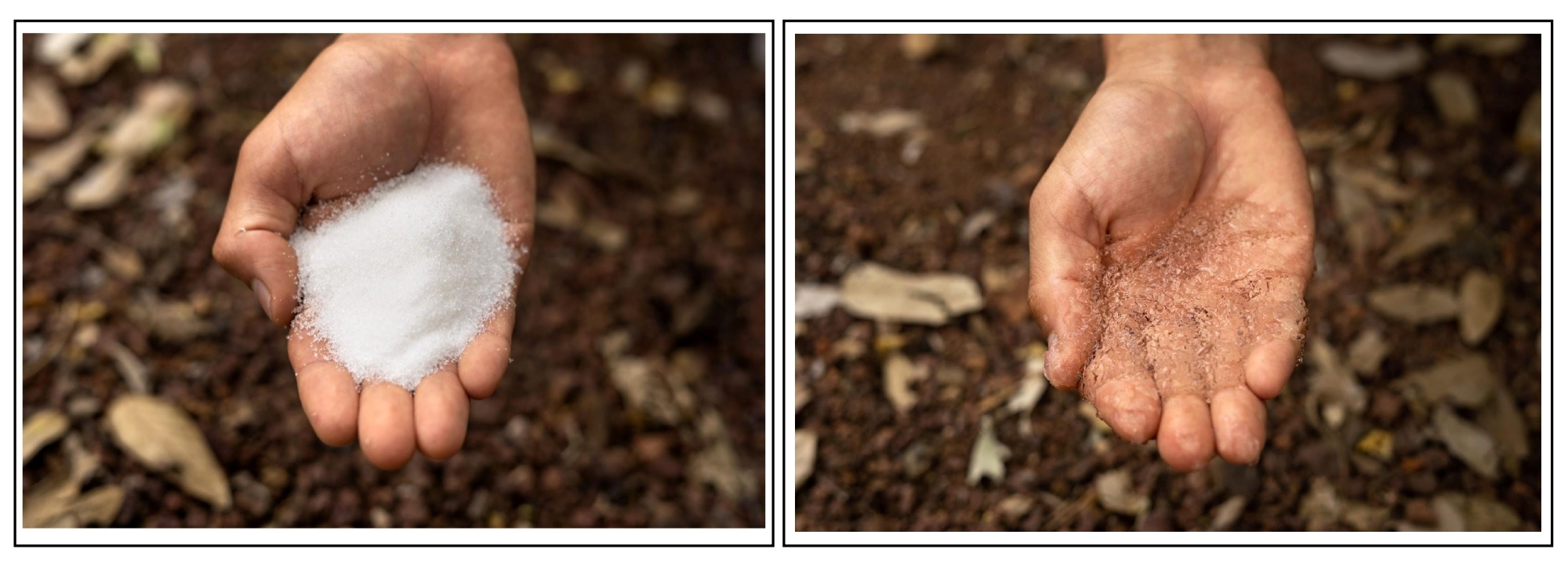
Hidrogel Technology in powder and gel once it has been mixed with water. Photo: Juan Manuel García
▪ BioChar, is a product of pyrolysis from agricultural or forest biomass under oxygen-limited conditions. The use of this technology can improve water retention and has demonstrated increased plant survival and growth at sites in other parts of the world. It has the added benefit of providing long-term storage of carbon in the soil. This would indicate that Biochar stimulates microbial activities, especially in soils with low fertility. This proposes that soils in arid Galapagos environments may not need to be "loaded" with compost or other organic matter.

Biochar Technology. Photo: Juan Manuel García
How does these technologies work?

Diagram of the Galapagos Verde 2050 Program where the use of water saving technologies is explained step by step.
RESTORATION ECOLOGY
The restoration process of endemic species begins with the collection of seeds from these species on their island of origin by the Galapagos Verde 2050 team. The germination process happens at the GNPD nursery, located on 100 hectares of agricultural land on Santa Cruz Island. It is nestled between the humid and transitional zones and has an area of approximately 2400 m².
When transporting the seedlings from Santa Cruz to the other islands, the Alive Organisms Transportation Protocol established by Galapagos National Park Directory is carefully considered. Once on the islands, we transplant the seedlings using these water saving technologies.
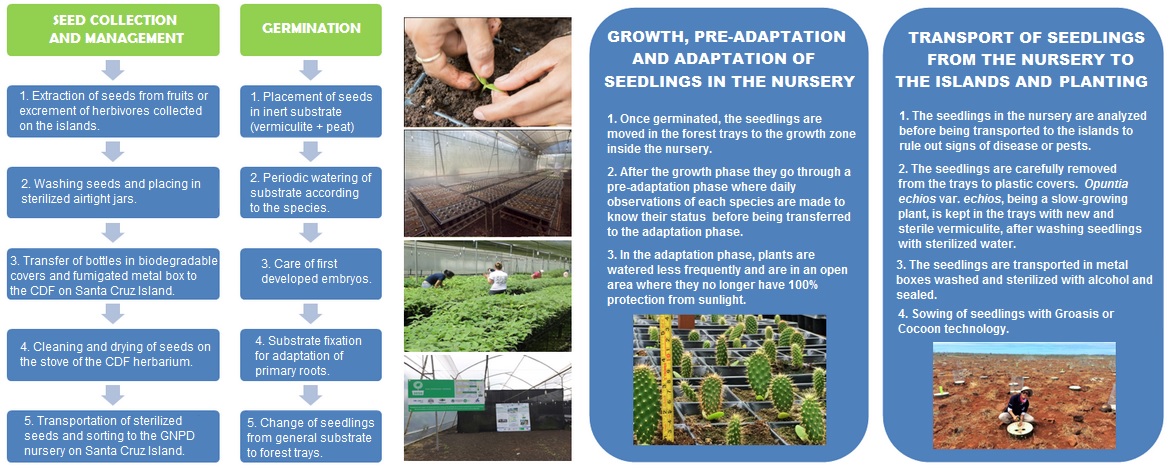
Scheme where the ecological restoration process carried out by the Galapagos Verde 2050 Program is explained in detail.
SUSTAINABLE AGRICULTURE: LOOKING TO THE FUTURE
In the last couple of decades, population growth in the Galapagos Archipelago has generated the permanent need of product importation from the continent mainland. These products constitute a risk of plagues and illness for the local crops.
By using Groasis and Cocoon technology for the agricultural production, Galapagos Verde 2050 strives to achieve self-sufficiency with a sustainable production, an alternative to the intense hydric resources used with conventional agricultural practices. We work with local farmers from different populated islands, achieving the priority objectives covered in the sustainable agriculture practices, for example, family crops.
The second phase of Galapagos Verde 2050, commencing November 2017, will be working in rural areas. Using ecological restoration actions, the key objective is to promote the recovery of altered ecosystems within farms. Galapagos Verde 2050 is presently evaluating the productivity and cost-benefit of the use of water-saving technologies in the production of first-necessity products in Santa Cruz and Floreana.
OUR RESULTS
ECOLOGICAL RESTORATION
Floreana Island: The black granite mine, a dry forest that was completely altered, in only 3 years it was restored to 100% of its historical diversity of endemic species. This makes it an example of a successful model of ecological restoration.
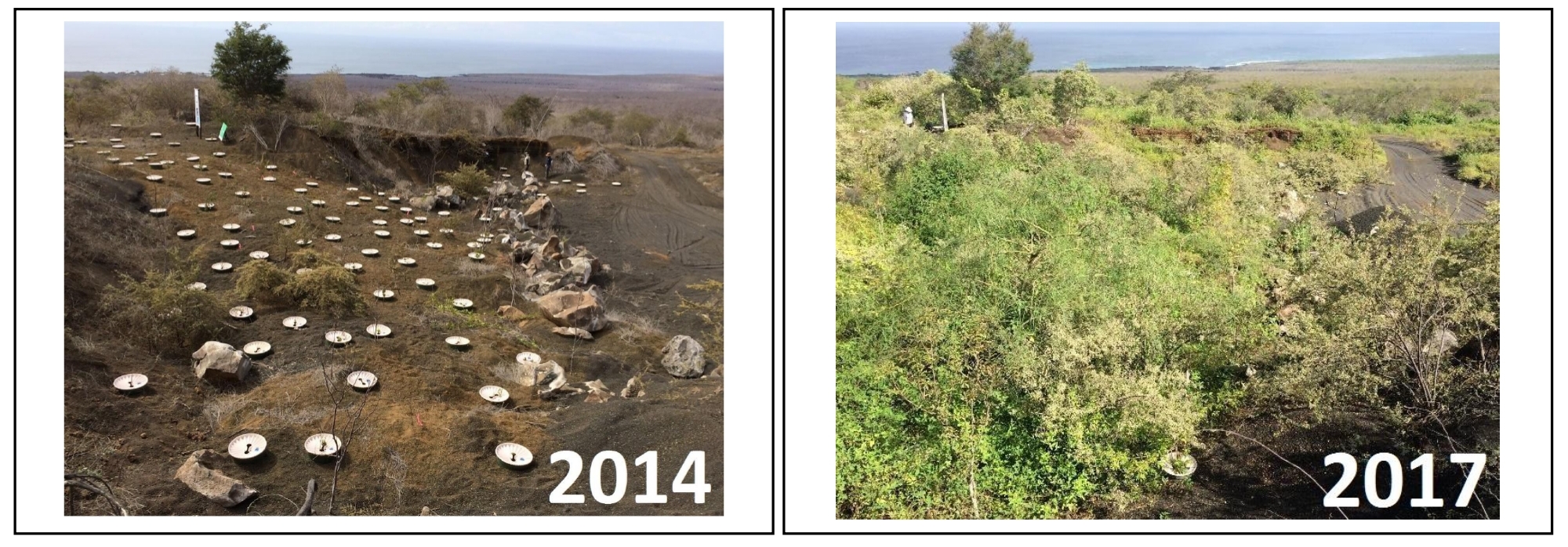
Images taken in August 2014 (left) and August 2017 (right) at the black granite mine (Floreana). Photos by Patricia Jaramillo Díaz.
Baltra Island: We have designed a protocol for the restoration of ecosystems in arid islands, using Baltra as an example, where we have planted more than 4000 plants of 12 different species. Currently, the project is in development on three hectares, and has created a corridor and an ecological garden in agreement with the ECOGAL Ecological Airport.
See video about first phase working on Baltra Island
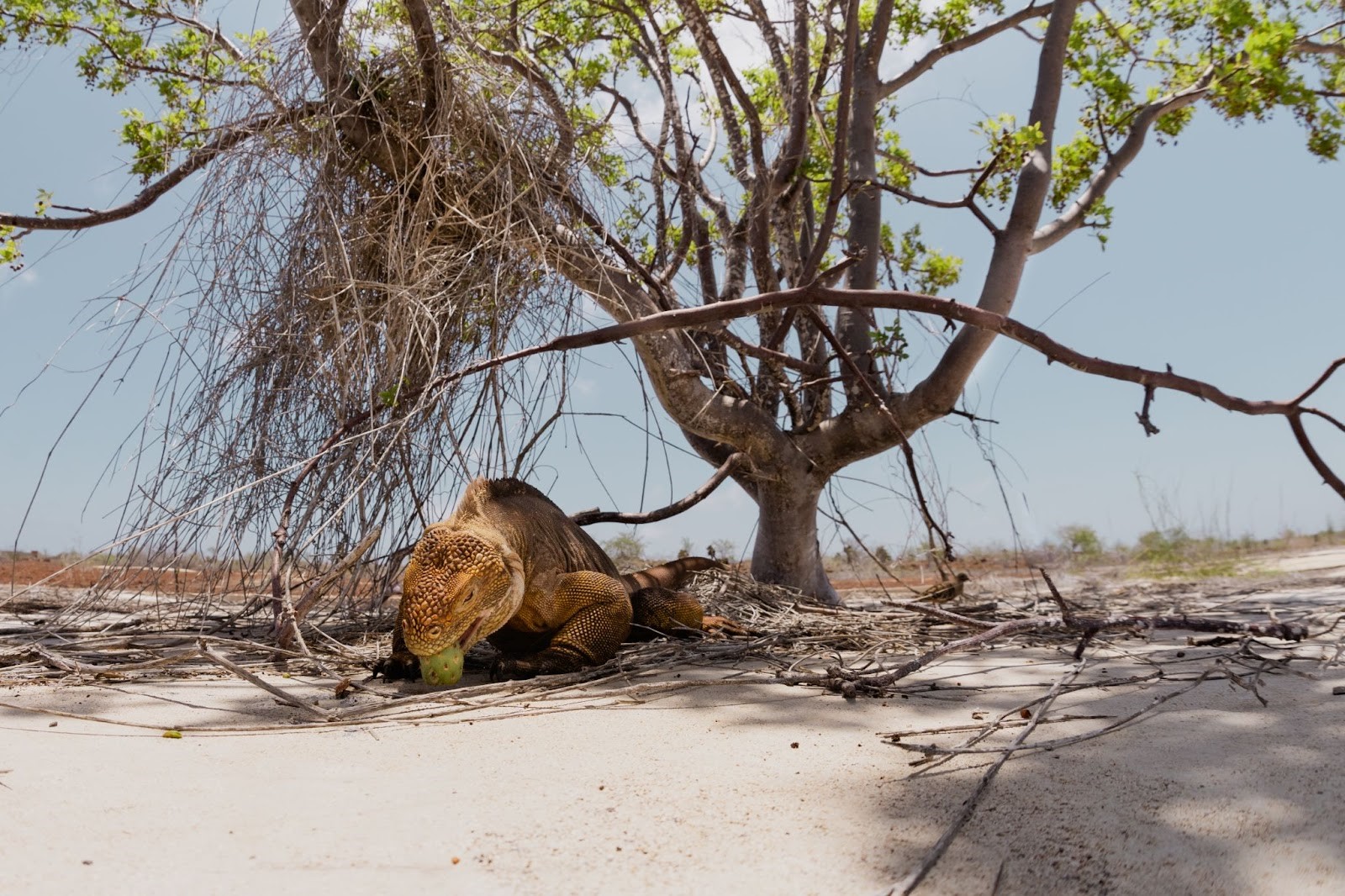
Land iguana under the shade of Bursera malacophylla and cactus fruit. Photo: Joshua Vela
Plaza Sur Island: In just three years, the population of Opuntia echios var. echios has tripled. After being a keystone species in the ecosystem and the main food source for land iguanas, the species declined in population by at least 60% in the last century.
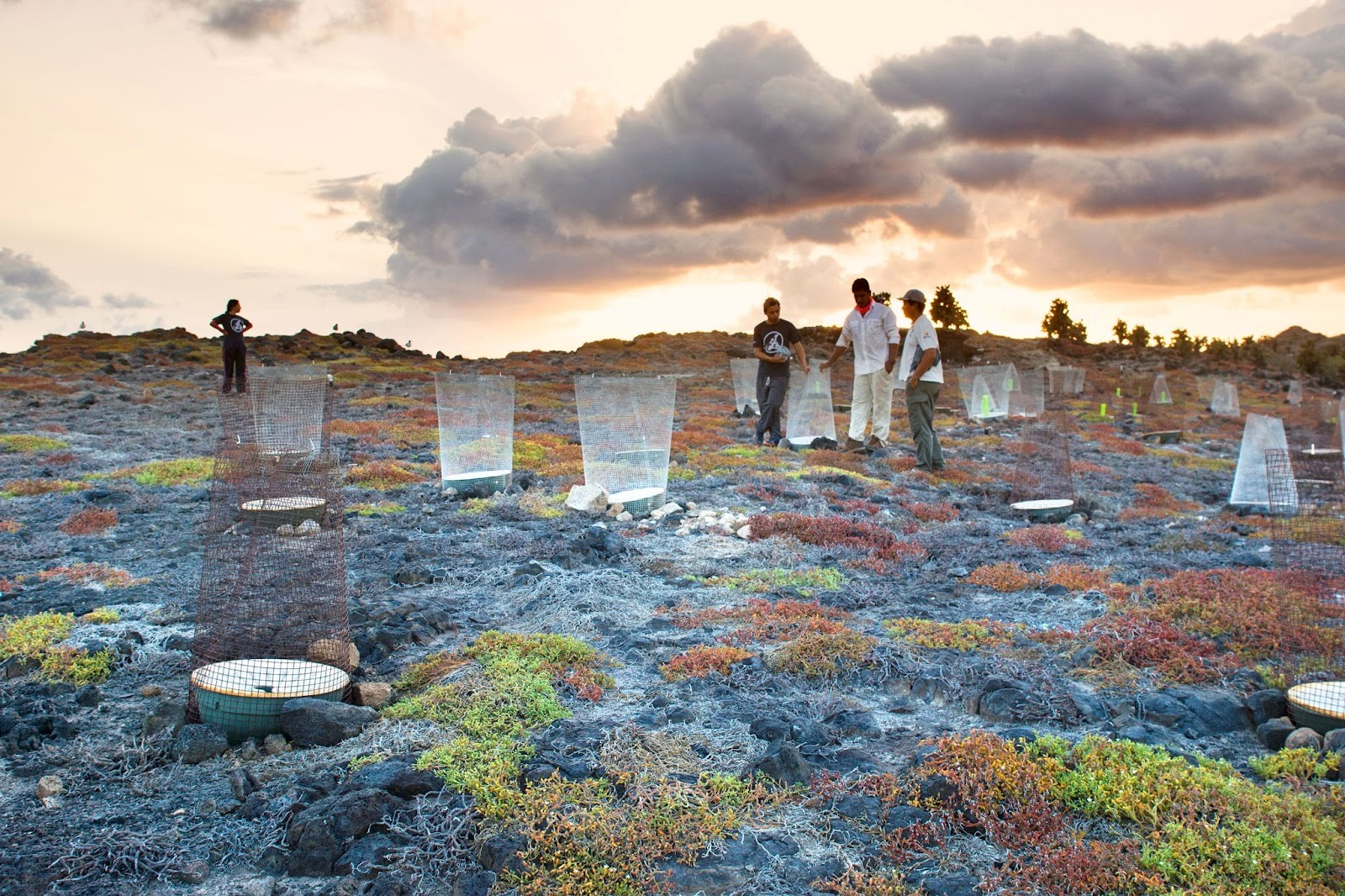
Ecological restoration of South Plaza Island through replanting of Opuntia echios var. echios. Team Galapagos Verde 2050.
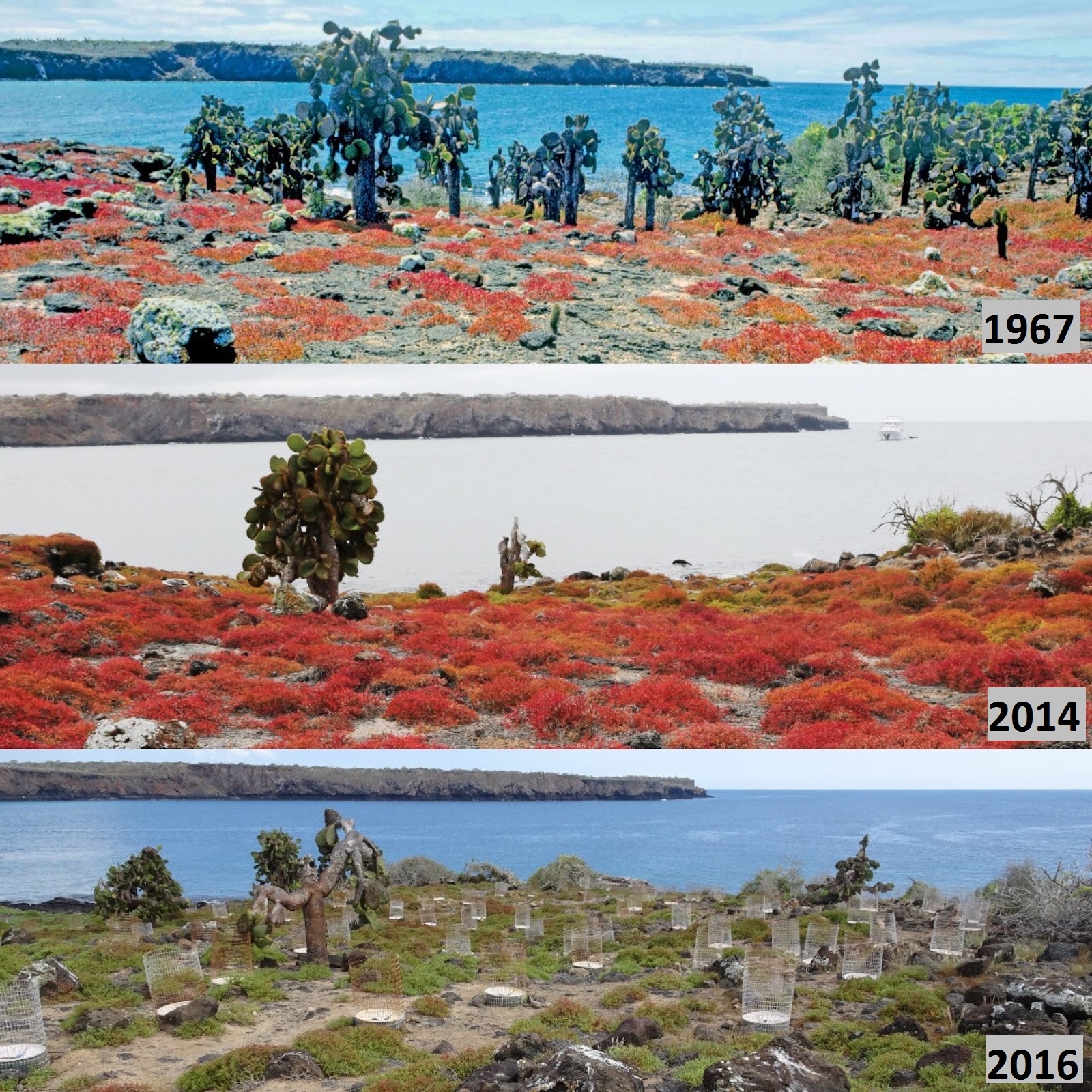
Evidence of population reduction of Opuntia echios var. echios on South Plaza Island prior to the arrival of Galapagos Verde 2050. Photographic sequence from 1967-2014 and actions carried out to recover the species (2016).
Santa Cruz Island: Scalesia affinis is another species that has declined significantly during the last century, but the efforts of GV2050 to restore its population have made it possible that the number of individuals increased by 35%. In addition to this, we have worked with several institutions to create ecological gardens using S. affinis. On top of that, a book was published, which was created to promote the planting of native and endemic plants in the gardens of the four populated islands.
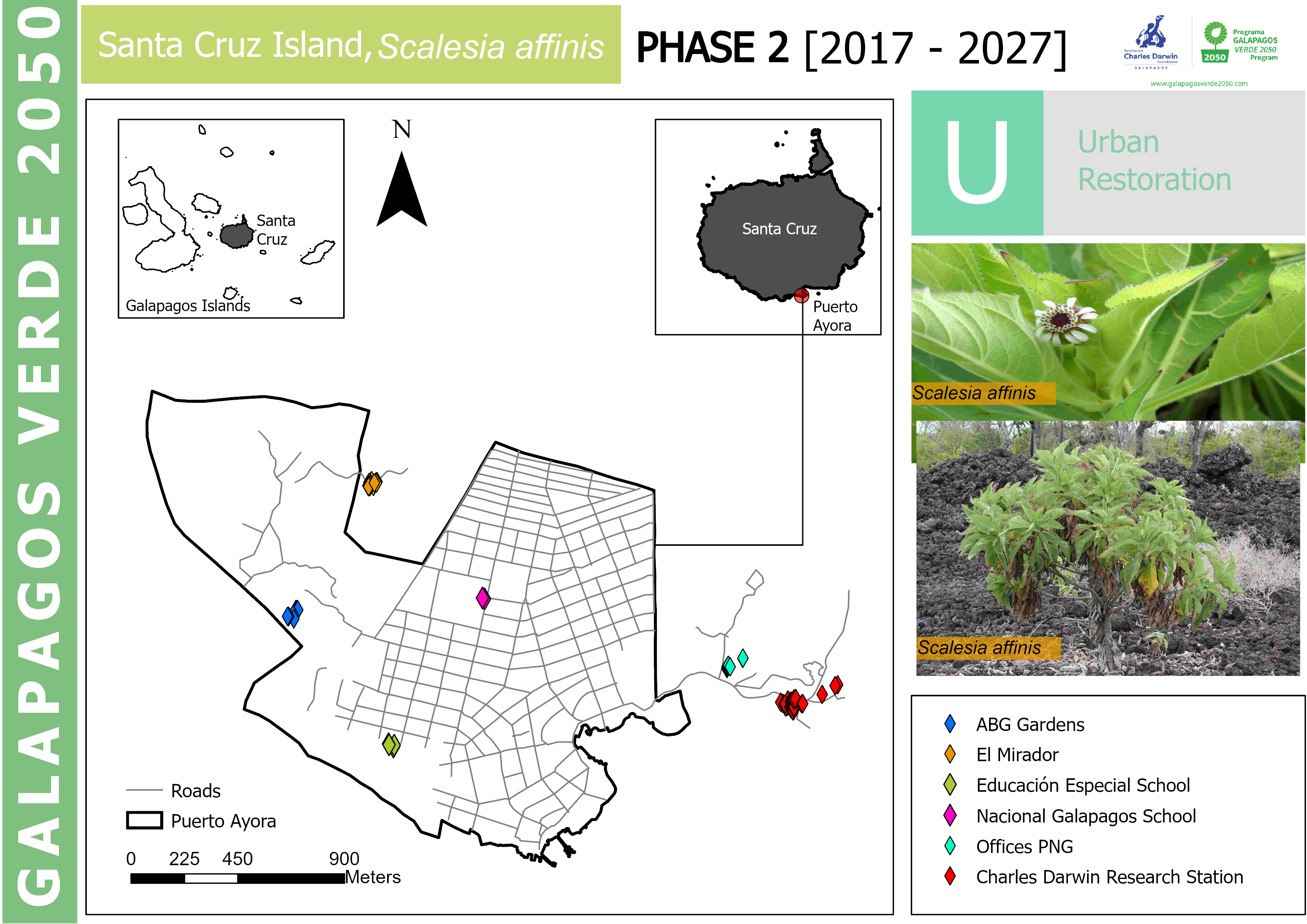
Map of the population distribution of Scalesia affinis in the urban area (Puerto Ayora) of Santa Cruz Island.
More information about Scalesia affinis:
- Endemic species restoration in Galapagos
- Scalesia affinis: An Endangered Specie
- Scalesia plantation using Waterboxx technology in Galapagos
Isabela Island: Galapagos Verde 2050 has succeeded in increasing the population of Galvezia leucantha subsp. leucantha by approximately 80%, and we are producing enough seedlings to increase its population fivefold over the next year.
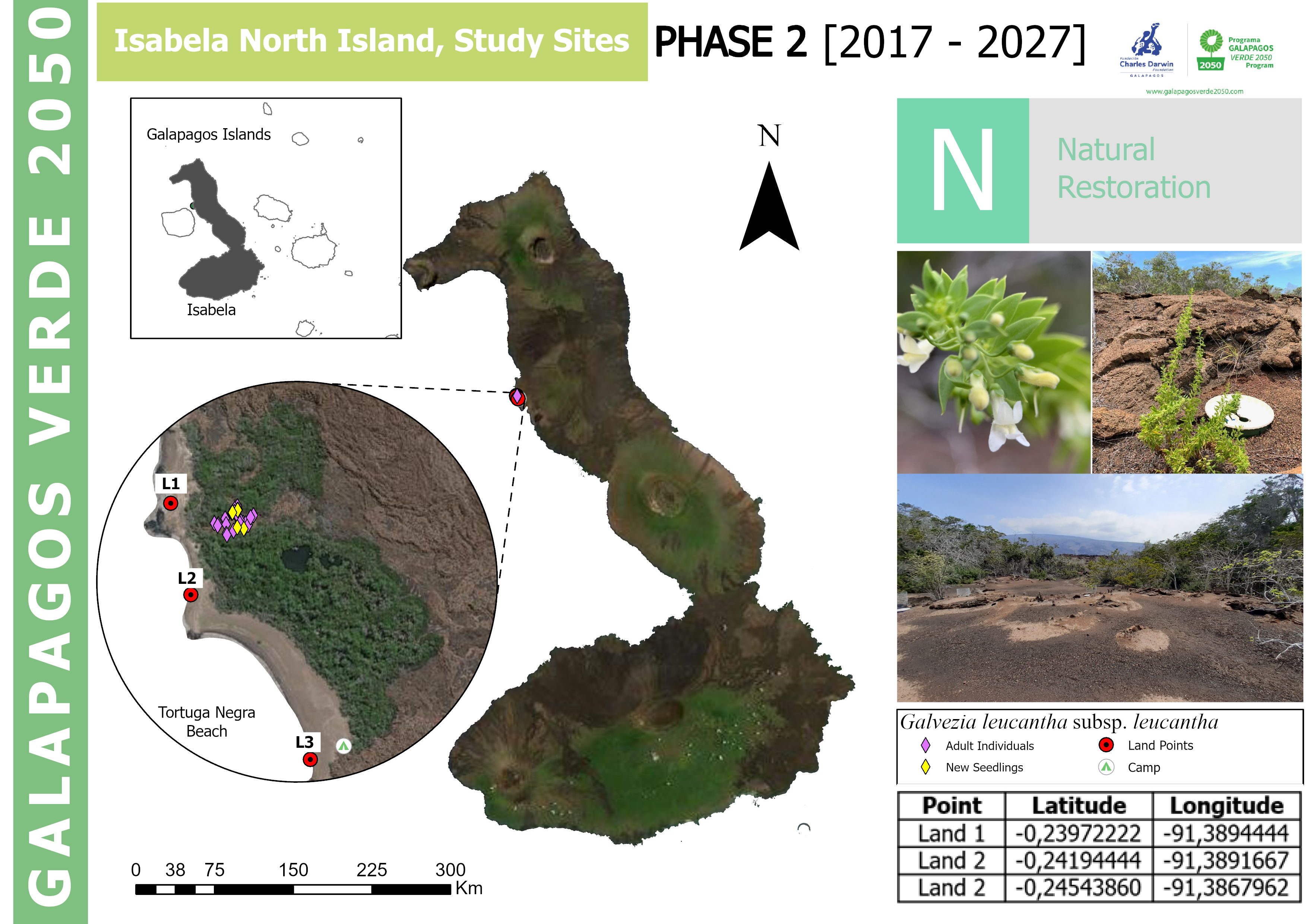
Map of the population distribution of Galvezia leucantha subsp. leucantha in the north of Isabela Island.
More information about Galvezia leucantha:
Española Island: We have developed a method for asexual reproduction of Opuntia megasperma var. orientalis and since 2017 we are testing ex situ germination trials using turtle droppings seeds. In addition, we have germinated enough L. lecocarpoides in the laboratory that we have attained a seed bank which allows us to advance in the studies to understand the germination mechanism of this plant and recover its species.
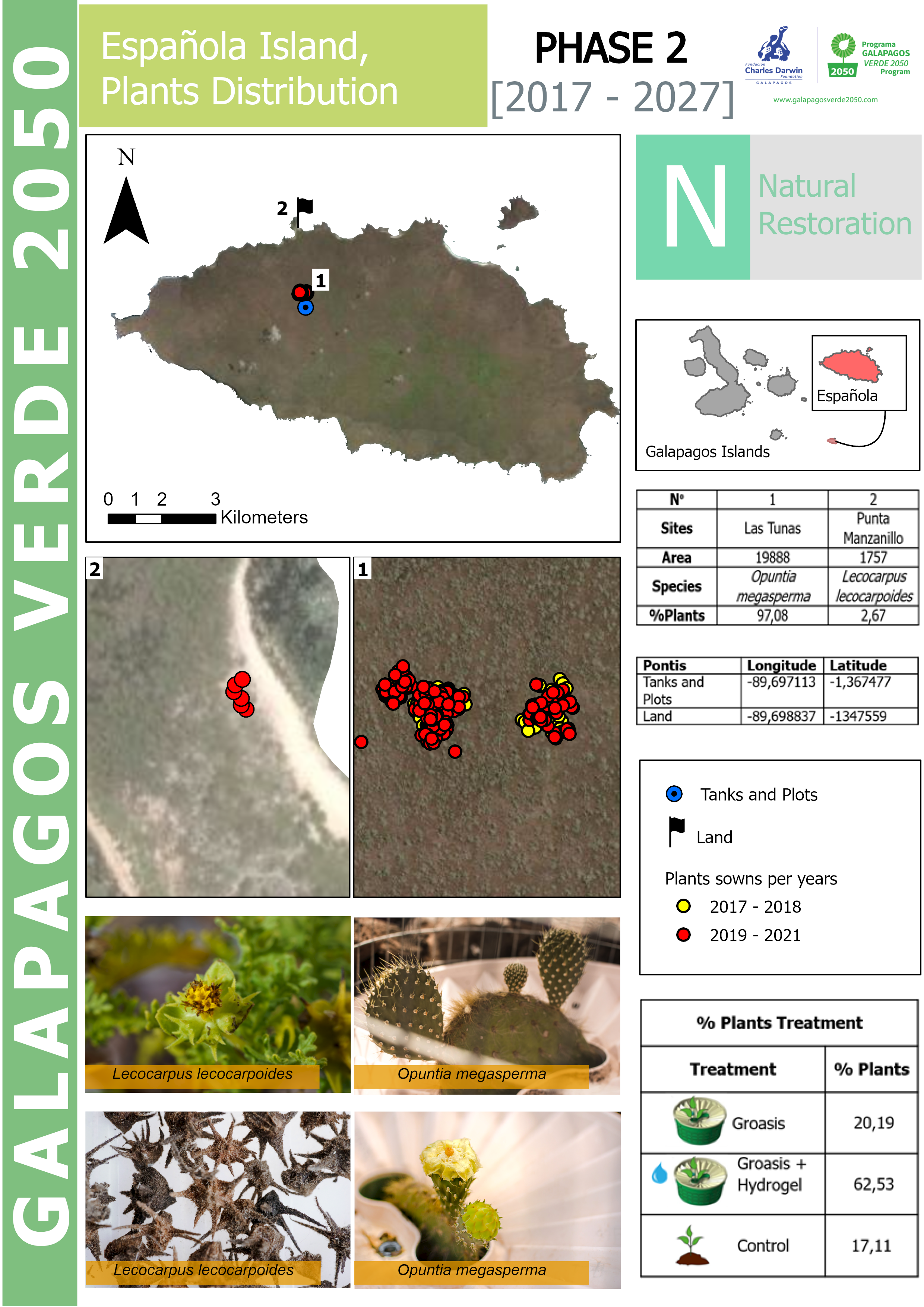
Map of the population distribution of Opuntia megasperma var. orientalis and Lecocarpus lecocarpoides on Española Island.
Read more about the success and experiences of scientists and visitors involved in this research project (Blogs):
EDUCATION AND SCIENCE COMMUNICATION
In addition to scientific research, Galapagos Verde 2050 is connected to the local community through a variety of activities. Examples include tools such as our publication of the first trilingual book that encourages the creation of ecological gardens using endemic and native Galapagos plants (Plant me in your garden), the book “The Galapagos Verde 2050 Project'' communicates and explains the mission and vision of the project over time and details the actions being developed for the ecological restoration of the archipelago, and the book “Guide to Galapagos Seeds and Propagules'' is useful when identifying all the seeds of native and endemic plants of Galapagos. In addition, we have organized workshops, conferences and various outreach activities at local, national and international levels.
See videos about Organization and structure book "Plant me in your garden"
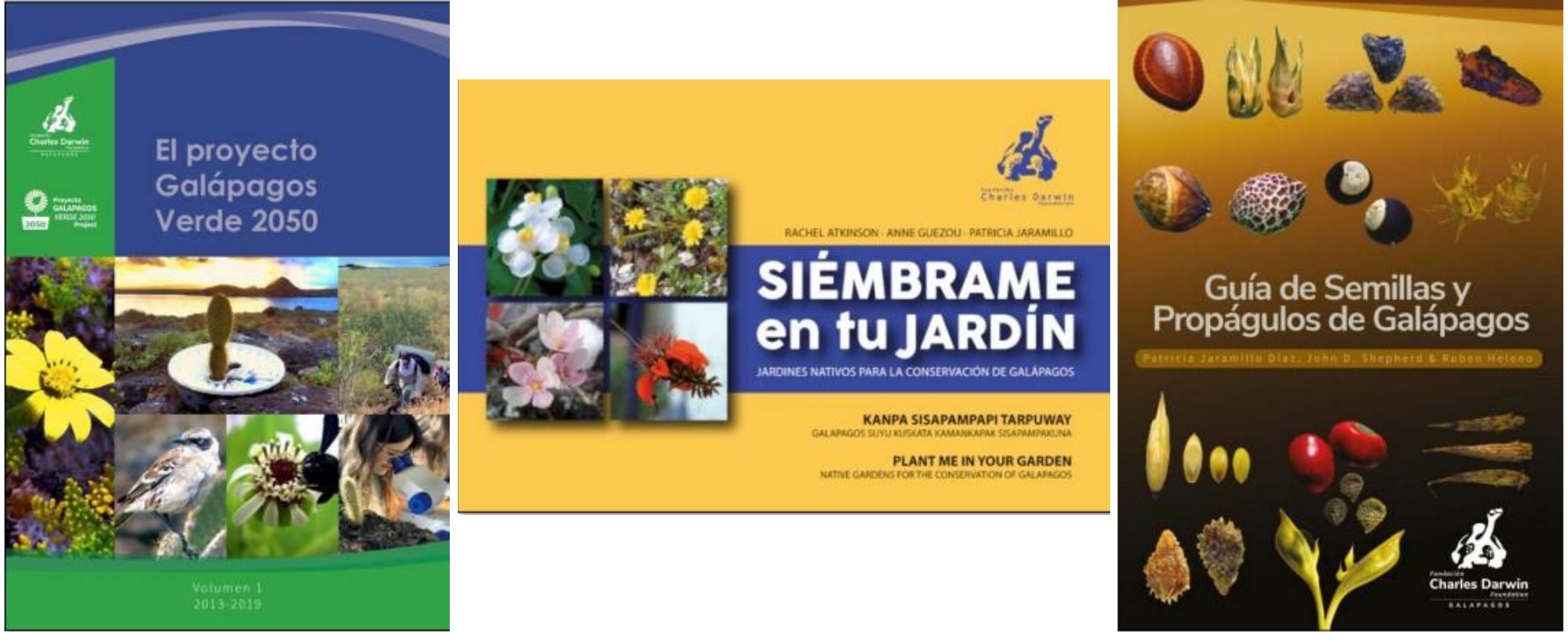
Books published by Galapagos Verde 2050 to inform and educate the general public about the flora of Galapagos and the progress of the program.
To convey with the community the importance of the endemic and native flora of Galapagos, we have developed illustrations of the most characteristic plants of the project study sites or those that are in danger of extinction, such as Scalesia affinis. With these illustrations we have been able to design promotional material to generate a sense of community ownership of the Galapagos Verde 2050 program and to raise awareness of the importance of recovering endangered species in the archipelago. These illustrations have been distributed among the population on various occasions through: Open houses, expeditions, new plantings with the community, commemorative days (such as Women's Day), etc.
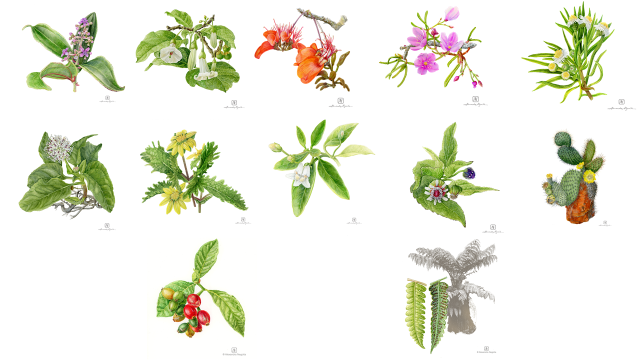
Illustrations of endemic and native Galapagos plants that are planted during the development of urban restoration and endangered species recovery projects.
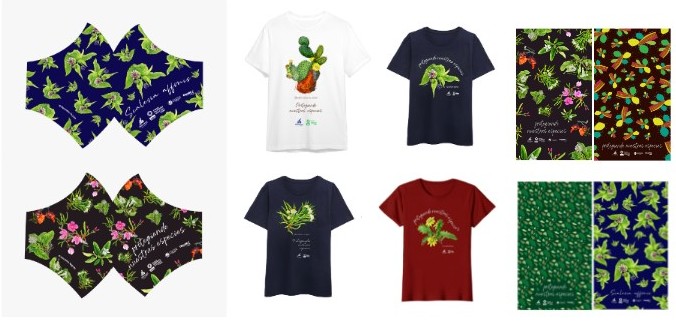
Promotional material for the Galapagos Verde 2050 program that includes 8 models of face masks, 8 models of T-shirts, 4 models of buffs and 1 model of bag to buy at the supermarket.
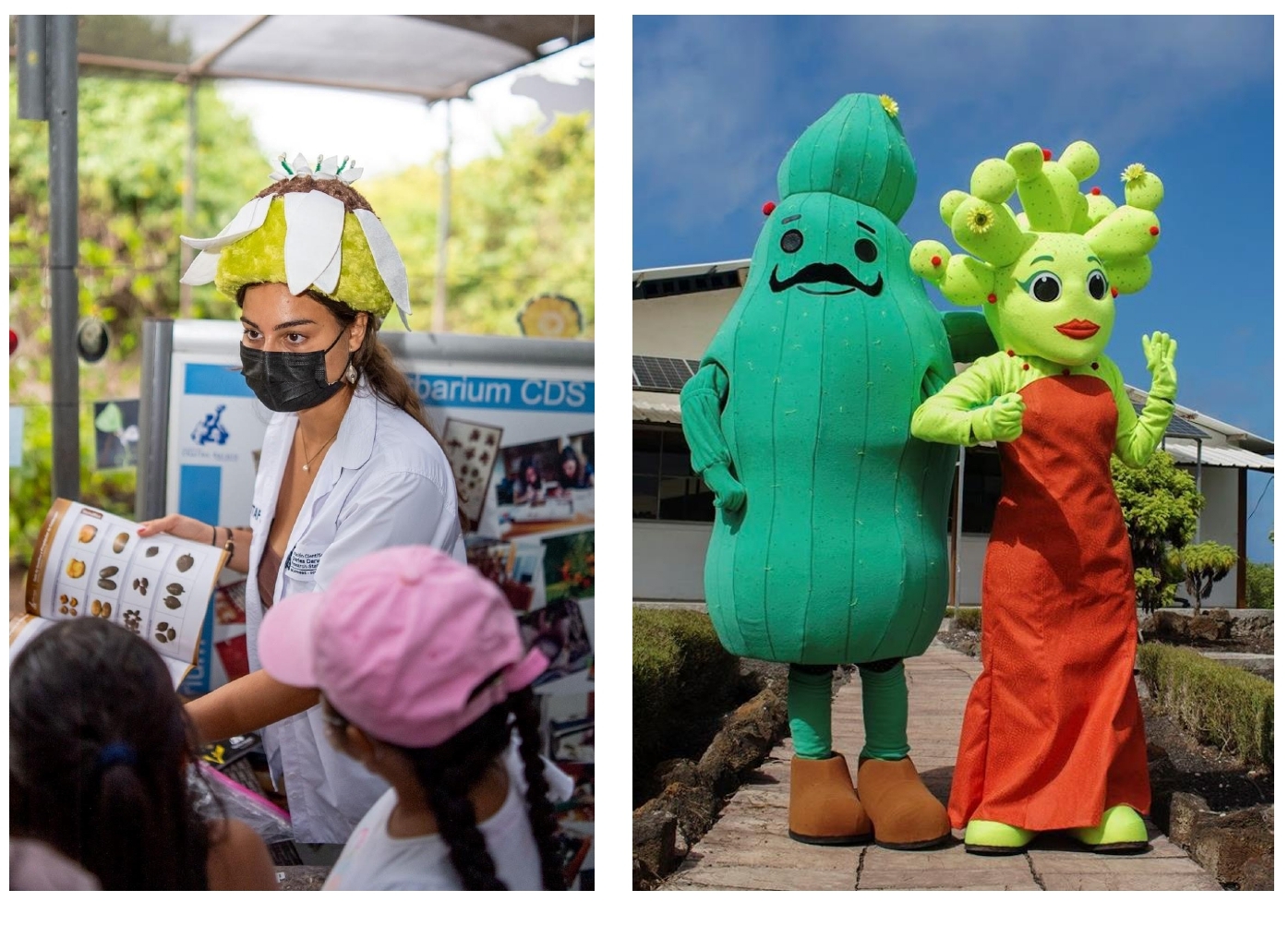
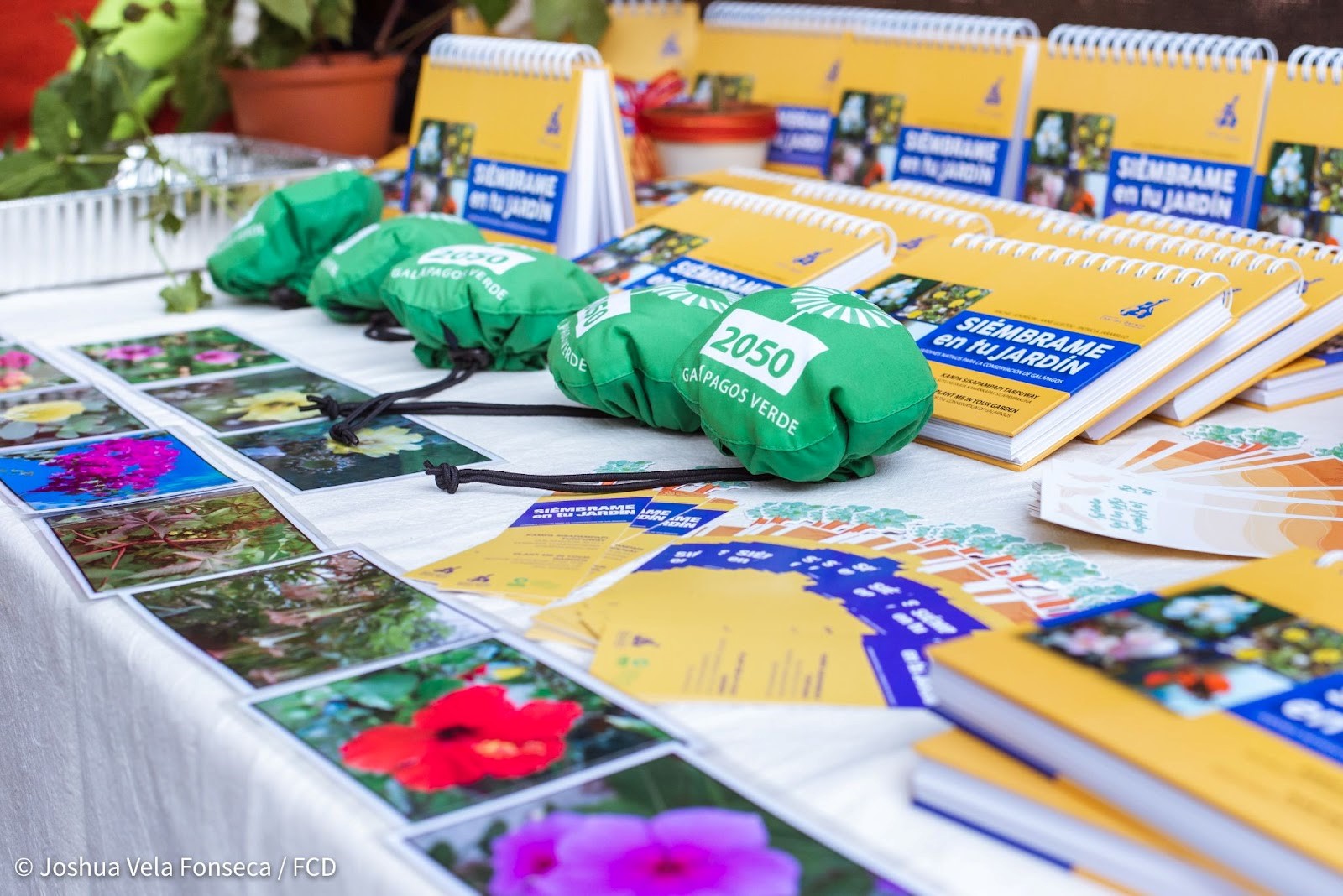
Galapagos Verde 2050 community events and distribution of promotional materials.
GREEN LATINOAMERICAN AWARDS
The Galapagos Verde 2050 initiative was a finalist in the fifth edition (2018) of the Premios Verde Latinoamericano and won THIRD PLACE in the "Water" category out of 2733 projects. Additionally, Galápagos Verde 2050 was awarded the Direct TV PROTAGONISTS award "For having been one of the most outstanding stories, the clarity of its purpose, its impact, its legacy and its ability to inspire positive change for the region and for the planet". Read more.
See videos about Galapagos Verde - Awards Summary:
Read more about the success and Green Latin America Awards for the Galapagos Verde 2050 (Blog):
DIRECTV PROTAGONISTS AND INSPIRING STORIES AWARDS
- Documentary Protagonistas 2019 (GV2050 from minute 6:40)
- Powerfull woman | Patricia Jaramillo - Ecuador
- Talk: Inspiring Stories - Sostenibility Week
 Donors:
Donors:

Partners:






